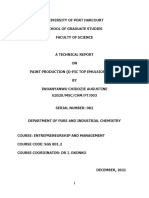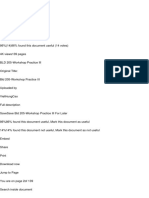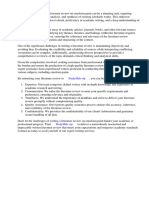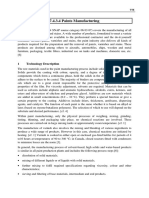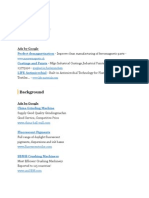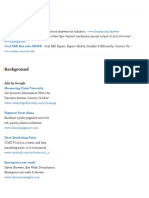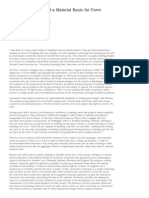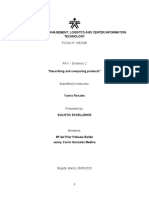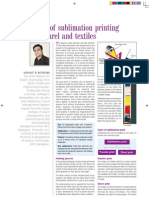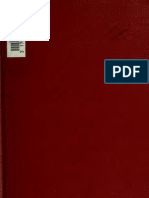Project Work On Texcoat Paint 1
Project Work On Texcoat Paint 1
Uploaded by
iykeejimCopyright:
Available Formats
Project Work On Texcoat Paint 1
Project Work On Texcoat Paint 1
Uploaded by
iykeejimOriginal Title
Copyright
Available Formats
Share this document
Did you find this document useful?
Is this content inappropriate?
Copyright:
Available Formats
Project Work On Texcoat Paint 1
Project Work On Texcoat Paint 1
Uploaded by
iykeejimCopyright:
Available Formats
1
PROJECT ON
THE PRODUCTION OF TEXCOAT PAINT
PRESENTED TO THE DEPARTMENT OF CHEMICAL
ENGINEERING
INSTITUTE OF MANAGEMENT AND TECHNOLOGY
(IMT) ENUGU.
SUBMITTED
IN PARTIAL FULFILLMENT OF THE REQUIREMENT
FOR THE AWARD OF HIGHER NATIONAL DIPLOMA
(H.N.D)
AT
DEPARTMENT OF CHEMICAL ENGINEERING
INSTITUTE OF MANAGEMENT AND TECHNOLOGY (IMT)
ENUGU
DECEMBER, 2010
LETTER OF TRANSMITTAL
Department of chemical Engineering,
Institute of Management and Technology,
Enugu.
21st December, 2010.
Head of Department,
Chemical Engineering Department,
Institute of Management and Technology,
Enugu.
Sir,
SUBMISSION OF HND RESEARCH PROJECT
The project on the production of texcoat paint was carried out,
written by the under listed students, and we hereby present the
report to the department of chemical engineering, IMT, Enugu,
in partial fulfillment for the award of Higher National Diploma
(HND) in Chemical Engineering.
Yours faithfully,
CERTIFICATION/APPROVAL
This project, titled production of texcoat paint, meets the
regulations governing the award of Higher National Diploma
(HND) in chemical Engineering in the Institute of Management
and Technology, Enugu and it is approved for its contribution
and literary presentation.
DEDICATION
To God be the Glory
ACKNOWLEDGEMENT
We are grateful to God almighty who has brought us thus far.
We are so much appreciative of the fact that he gave us the
strength, health, and above all things, life for the achievement
of this project.
We are also thankful to our able supervisor, Engr. M.I. Ede,
whose presence and corrections encouraged the hard work and
oneness enjoyed during this project. We also extend the heart
felt
gratitude
to
the
head
of
department
of
chemical
engineering whose immense contributions to the academic
lives of student will never be forgotten in years to come.
To parents, friends and relatives whose support has led to the
success of this project, may the blessings of God continue to be
abundant in their lives. Amen.
ABSTRACT
Texcoat paint is a substance that consist of a pigment and
marble dust suspended in a liquid or solvent such as water, etc.
Text coat paint is quite different from other kinds of paints. It
possesses a distinguishing characteristic of rough texture and
appearance. Texcoat paint consist of other raw materials such
as, Nitrosol, Acrylic, Calgon, Ammonia, Nepaid, Dolomite,
Colour paste, etc. The aim of the project is focused on the
production of a texcoat paint.
These raw materials were first formulated in the right
proportion and volume. It was the tabulated formulation that
was used in the manufacture because a targeted quantity and
quality is expected. Many vital conditions for production such
as the use of clean water, continuous stirring, etc were always
observed. Stirring was maintained at a uniform speed through
out the production process.
When clean water was first added to the reactor, stirring
began, and other raw materials were sequentially added and
stirred to satisfaction until a texcoat paint was formed. Then,
the temperature and other parameters to be tested were
observed, recorded and compared with the Nigeria industrial
standard specifications. It is important to note that after the
production at large quantity, then colours were added to the
proportion needed. Other standard and uncommon colours
were produced by mixing the primary colours at the right
proportion.
The product was packaged in a plastic container at different
quantities and colours. As days go, samples were collected
from the packaged product to test and make observations as
and when necessary.
Additionally, colour comparison with a
colour chart was done to confirm the colour standard produced.
No parameter was left unchecked because failure of any
parameter to meet with the standard specification defaults the
quality of the paint.
The result below is the result obtained from the analysis carried
out during and after production. They are as follows:
Table 1
a
Parameters
Composition
paint
in
solvent
in No lump(s), skin and offensive
Condition
c
d
e
f
g
h
i
container
PH value
Temperature
Specific gravity
Viscosity at 26oc 20c
Fastness to light analysis
Water drop text
Resistant to stains
j
k
after drying
Dilution stability
Normal dilution
Storage for 1 month (4 No
sign
of
weeks)
Drying time
degradation after some weeks
42 minutes surface dry, 1hrs
Net weight
Colour
PVC content
Refractive index
Appearance on application
45minutes hard dry
239g
Assorted colours produced
20% by volume
1.32
Normal and smooth
m
n
o
p
of
Result obtained
Homogenously dispersed
odour
8.0
26oc
1.06
Nil
Little colour change at drying
No sign of film breaking
No signs of chalking stains
biochemical
Brushability
Normal and smooth
10
TABLE OF CONTENT
Title Page
Letter of Transmitted -
ii
Certification/Approval -
iii
Dedication
iv
vi
1.3 Aims and Objectives
1.4 Definition of Terms -
1.4.0Decoration
Acknowledgement
v
Abstract -
Chapter one
1.0 Introduction
1.1 Historical Background
1
1.2 Statement of Problem
4
4
1.4.2Emulsion -
11
1.4.3Texture
1.4.4Patent
1.4.5Stabilizer -
1.4.6Synthetic -
1.4.7Polymers -
1.4.8Poisonous -
1.4.9Pigment
1.5.0Corrosion -
1.5.1Opacity
1.5.2Insoluble -
1.5.3Binders
1.5.4Volatile
1.5.5Pollution -
1.5.6Formula
1.5.7Ingredients
6
1.5.8Grinding -
1.5.9Let Down -
1.6.0Shading
1.6.1Thinning -
12
1.7 Research Method
1.8 Scope and Limitation of Study -
1.9 Significance of Study
2.10 Raw Materials for Paint Production -
Chapter Two
2.0 Literature Review
9
2.1.1Metallic Pigments
10
12
2.2.0Types of Texcoat
10
2.1.2Binders
2.1.3Volatile Solvent
11
2.1.4Additives -
12
13
2.3.0General qualities of Texcoat Paint
13
2.4.0Texcoat Paint Formulation-
14
2.5.0Production Method -
14
2.6.0Commercial Production
15
2.6.1Grinding -
15
2.6.2Let Down -
16
2.6.3Shading
16
2.6.4Thinning -
16
17
3.1 Instruments used in Production
3.2 Raw Material for Texcoat Paint Production
Chapter Three
3.0 Methodology
17
18
3.3 Production Procedure
18
3.4 Colours and their Production
19
14
3.4.1Blue -
19
3.4.2Lemon Green
20
3.4.3Sea Green
20
4.0 Experimental Result -
21
4.1.0Table 1
20
3.4.4Ash Colour
20
3.4.5Yellow
Chapter Four
21
5.0 Discussion
26
6.0 Conclusion
Chapter Five
24
5.1 Table III
Chapter Six
28
Chapter Seven
15
7.0 Recommendation
32
30
8.0 Reference -
CHAPTER ONE
1.0
INTRODUCTION
1.1
HISTORICAL BACKGROUND
Paint is a term used to describe a number of substances that
consist of a pigment suspended in a liquid such as oil or water.
With a brush, roller, or a spray gun, paint is applied in a thin
coat to various surfaces such as wood, metal, concrete or
stone. Although the primary purpose is to protect the surface to
which paint is applied and provide decoration of surface.
Texcoat paint on the other hand is a kind of paint which has a
different character from emulsion and gloss paint. The paint is
known to possess a distinguishing character of rough texture
and rough appearance on any surface applied. The roughness
is provided by the materials used in the manufacture which are
16
not found in emulsion paint. This distinguishing character is
provided by the present of sharp marble dust.
Samples of the first known texcoat paint was made between
20,000 and 25,000 years ago. As a protective coating, paint
was first used by the Egyptians and the Hebrews who applied
pitches and balsams to the exposed wood of their ships. During
the middle ages, some inland wood also received protective
coating of paints, but due to the scarcity of paint, this practice
was generally limited to store fronts and signs. In Boston,
around 1700, Thomas Child built the earliest American paint
mill. The twentieth century has seen the most changes in paint
composition and manufacture.
The first paint was issued for a product that improved white
wash, a water slaked lime, often used during the early days of
the United States. In 1865, D.P. Flinn, obtained a patent for
water based paint that also contained zinc-oxide, potassium
hydroxide, ream, milk and linseed-oil.
17
In 17th century, in the 1620s the Dutch greatly increased
availability of white lead and lowered cost by invention of the
stack process. All white lead paints included chalk in their
undercoats, reserving purer white lead finish coats. Later in the
century, vermilion, a man made type of cinnabar, was
developed as was King yellow a manmade type of Orpiment.
In the 18th century, the discovery of Prussian blue provided a
much needed intense deep blue, readily available after 1724.
There was still no pigment resembling spectrum yellow and
consequently no brilliant green other than that produced from
arsenic. In 1778, a much less poisonous green was invented,
Scheeles Green; A break through came in 1781 with turners
patent yellow, though this still required varnish to preserve the
colour. In 19th century, the real water shed in the search for a
strong, light fast yellow came with the discovery of water
resistant chrome yellow in 1818.
Today, the twentieth century has seen the most changes in
paint composition and manufacture. At present, synthetic
pigments and stabilizers are commonly used to mass produce
18
uniform batches of paints. New synthetic materials developed
from polymers such as polyurethane, and styrene butadiene
emerged during the 1940s Alkyl resins were synthesized, and
they have dominated production service. Before 1930, pigment
was ground with stone nulls, and these were replaced by steel
balls. Today, sand nulls and high speed dispersion mixers are
used to grind easily dispersible pigments. Highly colourative
texcoat paint are produced, which have attracted high demand.
1.2.1
STATEMENT OF THE PROBLEM
The statement of the problem is the production of texcoat
paint.
1.3
AIMS OF OBJECTIVES
The aim of this project is for the student to know the production
of texcoat paint.
1.4.0
DEFINITION OF TERMS:
1.4.1
DECORATION:
Something pretty that you put onto
some thing else is order to make it more attractive.
19
1.4.2
EMULISION:
mixture
of
liquids
that
do
not
completely combine, such as oil and water, (2) a type of paint
used inside buildings on walls or ceilings that is not shiny when
it dries.
1.4.3
TEXTURE: The way a surface, substance or material
feels when you touch it, especially how smooth or rough it is.
1.4.4
PATENT: A legal protection given to a product to avoid
unlawful duplication of the product.
1.4.5
STABILIZER:
A chemical that helps something to
remain in the same state.
1.4.6
SYNTHETIC:
Combination
of
different
artificial
substances rather then natural.
1.4.7
POLYMERS: A chemical compound with a simple
structure of large molecules.
1.4.8
POISONOUS: Full of unpleasant and unfriendly feelings
and sense.
1.4.9
PIGMENT: A dry coloured powder mixed with oil, water
to make paint.
20
1.5.0
CORROSION: A state of deterioration in metals caused
by oxidation or chemical action.
1.5.1
OPACITY: The phenomenon of not permitting the
passage of electromagnetic radiation.
1.5.2
1.5.3
INSOLUBLE: Ability not to dissolve in a liquid.
BINDERS:
This is the liquid that holds other raw
materials together.
1.5.4
VOLATILE: The ability of a liquid to change into
vapour under atmosphere conditions.
1.5.5
POLLUTION: The release of unwanted and life
threatening substances into the environment.
1.5.6
FORMULA: This is an arranged quantity of raw
materials used in the production to achieve a desired results.
1.5.7
INGREDIENTS:
The raw materials used in the
production.
1.5.8
GRINDING: This is the reduction into small and uniform
sizes of raw materials.
1.5.9
LET DOWN: Removal of ground materials from the mill.
1.6.0
SHADING: Is a confirmation of colours.
1.6.1
THINNING: Thickness adjustment.
21
1.7
RESEARCH METHOD
Going by the nature and demands of this topic, a broad
research method were used to guide and adequately provide
pieces of information needed. Such method include the
internet, text books in advance chemistry, the encyclopedia
Americana, World books project of other graduated students,
enquires from paint producers, enquires from raw material
sellers and paint sellers. Research and laboratory institutes in
Enugu was of major relevance.
1.8
SCOPE AND LIMITATIONS OF STUDY
This research topic has sincerely added much knowledge as far
as production and branding of a product is concerned. The
brand name as simple as it sounds, is comparatively difficult to
form. Inasmuch as we desired to originated the name from the
group.
Time greatly was an inevitable limitation to the success of the
study. Sacrifices were made so that the deadline was met.
Since we know that time is incompromiseable, more effort was
directed to the study.
22
Money on the other side became a deciding factor to the
success of the study. The decision to use foreign raw materials
in the production became contributive to the limitations
presented by money. And as students, faced with other
academic
financial
responsibilities
and
demands,
the
immediate financial response demanded by the study, was
temporarily put on hold for some time.
Also, the hiring of a competent and reliable production
equipment and tutor was second to none. Having known that
there are numerous road side paint producers, efforts to
identify an experienced and reliable producer proved abortive
for some time. Even at the time paint producing companies in
Enugu could not help in putting us through for the time being.
1.9
A
SIGNIFICANCE OF STUDY
chemical
engineer
by profession
is ground with
the
knowledge of converting raw materials and wastes to finished
products. To this the production of texcoat paint means to
23
expose the students to production norms and ethics, bearing in
mind the uncertainty of future.
A graduate of chemical engineer should be a provider of jobs
for other engineers and marketers, accountants, etc, without
much dependence on government for job and assistance
immediately after graduation.
24
CHAPTER TWO
2.0
LITERATURE REVIEW
According to George J. Danker, World book (2001), paint is a
substance that colours and protects a wide variety
of
substances. Also, texcoat pant is a paint used on inside walls
and outside of buildings, applied to a surface and forms a tin
solid layer when dried. The qualities and properties of texcoat
paints depend on the pigment and other solvents used in the
production. Texcoat paint can be manufactured from different
raw materials depending on the used of the paint.
2.1 RAW
MATERIALS
USED
IN
TEXCOAT
PAINT
PRODUCTION
Richard, Encyclopedia Americana (2001) states that texcoat
paint is made and designed for special application and to
withstand unsual environmental conditions such as extreme
heat and cold, chemical attacks, fungus growth and high
humidity, etc. For this above listed purposes and more, texcoat
paint contains the following raw materials.
- Metallic pigment (aluminum, Zinc, and bronze)
25
- Binders or vehicles
- Volatile solvents
- Additives
2.1.1
METALLIC PIGMENT:
As Richard stated in Encyclopedia Americana (2001) that paint
are materials that impart colour and opacity to paint film. It
provides other essential properties such as hardness, film
strength, durability and corrosion resistance. Dyes a time are
used to impact colour, but they differ from pigments in their
solubility characteristics. While pigments are insoluble and are
dispersed in the paint binder, but dyes are dissolved in the
volatile material before being mixed with the binder. Some
pigments such as white lead for white pigment, titanium
dioxide, zinc oxide, zinc sulfide, have led to the production of
multi-pigment texcoat paint. Lead pigments are no longer used
in paint production because of their toxicity to life if ingested.
2.1.2
BINDERS:
26
Richard, Encyclopedia Americana (2001), continued by saying
that binders are the portion of the paint formula that hold the
other ingredients together and serve to form the solid film of
the paint. Also, the properties of the paint are controlled to
greater degree by the type of binder used. And such properties
are, drying rate, thickness and hardness of film, its durability
and weather resistivity and chemical resistance. Importantly,
the following are used as texcoat paint binders, vegetable oil,
seed oil, tungoil, soybean oil, castor oil, coconut oil, fish oil.
Others are, alkyd resins, vinyl types and amino, epoxy,
polyurethame,
silicone,
fluorocarbon,
polyamide,
resins,
polymers and copolymers, etc.
2.1.3
VOLATILE SOLVENT:
Also, Richard Encyclopedia Americana (2001) continued by
saying that volatile solvent or thinners are used in texcoat
paints to facilitate their application. Since most resins, oils, and
polymers used as binders are quite viscous, the viscosity must
be reduced so that the texcoat coating can be applied in a
uniform and smooth film. Water is also now used as volatile
27
solvent because of its universal availability and low cost,
freedom from air-polluting properties.
2.1.4
ADDITIVES:
In his findings, Richard, Encyclopedia (2001) said that additives
are added to paints mostly texcoat, to accomplish the specific
functions not accomplished by pigments, binders and volatile
solvents.
Additives
are
always
incorporated
in
small
percentages of the total formula to perform a variety of
important functions. Such functions performedby additives are
promotion of drying, promote the wetting of pigments to aid
pigment dispersion, prevent colour floating and flooding,
prevent uneven colour patterns in paint films, prevent pigment
from settling in paint containers, prevent skin formation in the
can, increase flow ability, prevents loss of drying ability during
storage, resist mildew growth on exterior exposure, help
prevent spoilage.
2.2.0
TYPES OF TEXCOAT PAINTS
28
George J. Danker, World book (2001) found that texcoat paint is
known to be of many types, depending on the ingredients used
in the production. The following are the types:
a.
SANDLESS TEXCOAT: George J. Danker World book
(2001), said that this is a kind of texcoat paint produced
with more of sandless dust as an additive. The distinctive
feature of this kind of texcoat is the smooth and sand less
appearance on application. And the ability to form a thin
layer on application.
b.
ROUGH TEXCOAT: George J. Danker World book (2001),
found that this is another kind of texcoat paint which
possess a rough appearance and thick film on application.
The production involves the use of marble dust of large
sizes.
2.3.0
GENERAL QUALITIES OF TEXCOAT PAINT
George J. Danker World book (2001), discovered that texcoat
paints are produced for house hold and industrial uses. They
include:
29
i.
Roughness and standard colour
ii.
High dry rate
iii.
Chemical resistance
iv.
Temperature resistance
v.
Weather resistance
vi.
Thickness
vii.
Long shelf life
viii. Uniform colouration and opacity
ix.
Flowability on application
x.
Resistance to fungus attack
xi.
Brushability on application etc.
2.4.0
TEXCOAT PAINT FORMULATION
Arthur Grebetz, World book (2001), define formulation as the
listing of all the raw materials to be used in the production of
high quality texcoat paint. The listing of the raw materials must
be to the correct proportion in quantity, and must be tabulated.
Texcoat paint formulation is therefore a question of balancing
the chosen components to the right proportion to produce paint
of desired properties. Therefore, it is very important in paint
30
formulating to have a fair and precise knowledge of the
properties expected of the paint.
2.5.0
PRODUCTION METHOD
According to J. Richard Encyclopedia Americana, (2001) texcoat
paint can be produced in different ways. Each production
method defines a desirable quality and finished product state.
Such methods are conventional liquid paint method and
powder coating method.
Powder coaling method is a method which does not require a
solvent to keep the binder and filler parts in a liquid
suspension. The coaling is applied elestrostatically and erred
under heat to allow it flow or form a skin. Powder coaling does
not emit any volatile organic compound(s), does not run or sag
when applied, easily recycle when over sprayed,etc.
Conventional liquid paints involves the use of solvent in its
production. Other properties include, the emission of organic
compound, runs or sags when applied, cannot be recycle when
sprayed.
31
2.6.0
COMMERCIAL PRODUCTION
Arthur Grebetz world book (2001), shows that texcoat paint
production involves four (4) basis steps, namely grinding, let
down, shading and thinning.
2.6.1
GRINDING:
This
involves
the
loading
of
an
appropriate amount of pigment, resin and various liquid
chemicals into a grinding mill. The mill grinds the ingredients
into a fine uniform material known as mill paste. The mill to be
used depends on the hardness of the paint and the fineness of
the grind required. The mill paste is produced either in batches
or continuously.
2.6.2
LET DOWN: After the pigment has been ground, more
resins are added to the paste in the mill along with a small
amount of solvent. The paste is then pumped out of the mill
through a strainer to a holding tank.
2.6.3
SHADING (TINTING): This is the most critical among
all steps involved in the manufacturing processes. This involves
comparing
produced
texcoat
paint
samples
with
colour
32
standard. Small amount of shading paste are added to the
texcoat paint to adjust the colour to the standard when
necessary.
2.6.4
THINNING: After the texcoat paint has been shaded to
the specification, the texcoat paint is thinned to the desired
viscosity (thickness) by carefully adding solvents to it. Finally,
the paint is filtered and canned for shipment
33
CHAPTER THREE
3.0
METHODOLOGY
3.1
INSTRUMENTS USED IN PRODUCTION
The production of texcoat paint was carried out by first
providing the needed equipment. The pieces of equipment
used are hereby listed as follows:
- Reactor
- Wooden paddle
- A transparent bucket with calibration (Litre)
- Hand gloves
- Chemical respirators
- A scale
-
Glass measuring cylinder
- Thermometer
- Plastic cup
3.2 RAW MATERIAL FOR TEXCOAT PAINT PRODUCTION
34
The raw materials used are as follows: Clean water, marble
dust, Nepacid, white titan, Dolomite, colour paste, Acrylic,
formation, calgon, nitrosol, Ammonia, Anti-foam, etc.
3.3 PRODUCTION PROCEDURE
Texcoat paint is known to be quite different from other types of
paints such as emulsion, gloss, etc. As a result, the raw
materials involved are different because of the major physical
properties texcoat paint possesses like rough texture, etc.
The process started with the measuring out of 25 litres of clean
water. The clean water was poured into a reactor. On stirring
the water, 6 table spoonful of calgon was added into the water.
The calgon is to help dissolve other ingredients to be added.
On continual stirring, 0.4kg of formalin was measured and
added into the reactor. Followed by the addition of 0.4kg of
white titan at two (2) minutes interval. Stirring continued until
the mixture turned white. The process continued with the
addition of 1.5kg of anti-foam, which makes the mixture
foamless on addition of other ingredients.
35
After this, 20kg of dolomite was added on continues stirring.
The reaction of dolomite was exothermic, involving the
evolution of heat at increased stirring. At the reduction of the
evolution of heat, 25kg of marble dust was added, and well
stirred to avoid clogging of the mixture. The mixture was
observed to be stronger and difficult to stirring. 4.5kg of acrylic
was added to the mixture, enabling all the ingredients to gum
together. Nitrosol of 5kg was dissolved in water and added to
the reactor on continued stirring. And finally, 4litres of
ammonia (NH3) was added and turned completely.
It is important to note that stirring of the mixture never
stopped even for a second till the mixture was confirmed a
texcoat paint of high quality. The resulting texcoat paint was
white in colour, from which other colours such as blue, orange,
chocolate, yellow, cream, etc were obtained. On the contrary,
the process did not involve filtration as recorded in the
literature review.
3.4 COLOURS AND THEIR PRODUCTION
36
3.4.1
Blue: The already produced white texcoat paint
was where 4 litres was measured out and poured into a reactor.
About 5ml of blue paste was added and stirred completely until
homogeneous colour was obtained.
3.4.2
LEMON GREEN COLOUR
4 litres of white texcoat paint was measured out and poured
into a reactor. An equal quantity of blue and yellow, 2.5ml
each, was measured and added, while the mixture was stirred
completely to obtain a homogeneous mixture.
3.4.3
SEA GREEN COLOUR
This colour was produced by first producing lemon green colour
paint. To which 5ml dark green paste was added and stirred.
3.4.4
ASH COLOUR
This was produced using a black emulsion paste and added it
into the white texcoat paint at measurable quantity.
3.4.5
YELLOW
This was achieve by adding a 5ml yellow paste into a 4litre of
white texcoat paint and properly stirred.
37
Finally, nepacid was added to all the paint before it is stored
38
CHAPTER FOUR
4.0
EXPERIMENTAL RESULT
A texcoat paint of good quality is expected to meet the
standard of the Nigerian industrial standard specifications. The
Nigerian Industrial Standard (NIS) specifications are tabulated
below in comparison with the analysis result.
4.1.0
TABLE II
Parameters
Composition
Nigeria Industrial
Standard (NIS)
Specification
Should be
Result obtained
from product
paint
Homogenously
homogenously
dispersed
dispersed in the
solvent
solvent
Condition of paint Free from
lumps No
in
lump(s)skin
in container
skin, and offensive and
offensive
PH Value
Temperature
Specific gravity
Viscosity at
odour
7.0 to 8.5
260c + 2 0c
1.03 1.10
Nil
odour
8.0
260c
1.06
Nil
260c 20c
Fastness to light
Should possess
Little colour
39
analysis
little or no colour
change
Water drop test
change at drying
Should be free from
At drying
No sign of film
wrinkling and film
breaking
breaking
Resistant to stains Should be free from
No sign of
chalking stains after chalking stains
Dilution stability
drying
Diluted to normal
after drying
Normal dilution
Storage for 4
stability
Free from
No sign of
weeks 1 months
suspension,
biochemical
offensive odour and
degradation and
biochemical
offensive odour
degradation
45 minutes surface
after some weeks
42 minutes
dry and 2hrs hard
surface dry and 1
dry (maximum)
hour 45 minutes
Drying time
Net weight
colour
PVC Content
Refractive index
Appearance on
hard dry
220g 240g
239g
Any standard colour Assorted colours
20% max 19% min
1.33
No lumps, normal
produced
20% by volume
1.32
All properties met
40
application
flow, smooth with
Brush ability
brush
Normal and smooth
Normal and
smooth
41
CHAPTER FIVE
5.0
DISCUSSION
Paints generally are known and used for beautifying objects,
mostly buildings and the likes. A quality paint depends on the
materials used and their formulation. Texcoat paint has a single
distinguishing characteristic which on touch or application
stands out among others. This is as a result of the use of
marble dust in the production.
However, before any paint is made the first things is the
formulation of the paint or raw materials so as to meet the
desired quality and quantity. The formulation is done in a
tabular manner and in specified quantity of the raw materials
to be used. The production properly commences when this raw
materials are proportionally and sequentially mixed with each
other. Bringing about a chemical reaction to bind them together
to yield a product which finally becomes a texcoat paint.
At some point in time, observations as result of chemical
reaction are made, such as, evolution of heat, change in colour,
42
bubbles and foam formation, change in thickness etc. these
indicated the progress of the production processes, and all
these must be at steady stirring of the solution. Raw materials
must be correctly measured and as well added on time.
The production was aimed at producing at most 60litres of
texcoat paint of different colours. And to this, a batch method
of production was used others, like continuous method of
production would have been appropriate if it were for
commercial
purpose.
All
equipment
used
was
not
contamination, and was neat in order not to interfere with the
colour and quality.
Colours of texcoat paints are basically gotten by the addition of
single primary colour(s) as the case may be. Other uncommon
colours are not primarily gotten from primary colours, rather
they are produced by the combination of different primary
colours at the right proportion.
Paints are identified by the colour code on the labels such
colours like gray, calabash, lemon, etc have different colour
codes. Even colours which appear to look alike are coded
43
differently. The colours to be used could be in the form of paste
or dye. But must be well dissolved and properly mixed so as to
achieve a uniform colour.
A batch method was used in the production which enabled for
the actualization of the aim. The batch method enabled the
thorough mixing of all the raw materials used. Truly, this
method involves higher energy consumption but was effective
in making observations and other needed parameters to the
tested.
In addition, the raw material formulation used is shown in the
table below.
5.1
TABLE III
Step
I
II
III
IV
V
VI
VII
VIII
IX
X
XI
XII
Raw Materials
Clean water
Calgon
Formalin
White titan
Anti- foam
Dolomite
Marble dust
Acrylic
Nitrosol
Ammonia
Nepacid
Colours
Quantity
25 litres
6 spoonful
0.4kg
0.4kg
1. 5kg
20kg
25kg
4.5kg
5kg
4litres
0.5litres
5ml each
44
45
CHAPTER SIX
6.0
CONCLUSION
The production of the texcoat paint was successfully completed
using
patch
formulation.
The
method
whole
of
production
process
was
and
found
tabulated
interesting,
comprehensive and easy, as if the production were never the
first time. This is because the formulation table and the labels
on the raw materials helped in reducing the time which would
have been wasted in locating each raw material.
Considering the huge energy consumption involved in stirring
the mixture, the batch method used in the production
contributed in producing lumbless texcoat paint. The batch
method was also useful in loading a controllable quantity of raw
materials.
On the other hand, the raw materials were carefully handled
during the production. Some which were in powdered form
were properly dissolved in a solvent before they were added to
46
the mixture. Other things which contributed to achieving the
result include; steady turning, accurate measurement, etc. the
water used in the production was a clean, and no raw material
was left out, omitted or wrongly substituted.
The containers used in packaging the product were properly
washed and rinsed with clean water. All these above explained
production method and precautions which must be adhered to
if a good texcoat paint is to be produced.
It is important to state clearly that the raw materials and the
method used in the production, met all the qualities stated in
the literature review. Such qualities like preventing skin
formation, preventsing colour floating and flooding, preventing
uneven colour pattern in paint films etc. was tested and
confirmed.
47
CHAPTER SEVEN
7.0
RECOMMENDATION
Having locally produced a texcoat paint by using batch method,
the paint meets the specification of the Nigeria Industrial
Standard (NIS): a body regulating the standards of industrial
products. I hereby recommend that;
i.
A coincised and accurate formulation must be first
prepared before
production commences.
ii.
Raw materials to be used must be accurately measured.
iii.
A continuous stirring must be observed until the product is
formed, packaged and sealed.
iv.
Time interval for each reactant should be maintained at
minimum of three (3) minutes.
v.
It will be a step in the right direction if the government
can encourage and support more research work in texcoat
paint production so as to improve made in Nigeria texcoat
48
paints and curtail the importation of foreign texcoat paints
into the country.
vi.
A mechanized reactor with an electrically powered stirrer
should be used. This is because manual stirring is energy
and time consuming.
49
REFERENCE
Osei Yaw Ababio (1997), New school chemistry
New Edition, Africana Fep- Publishers,
Onitsha Pp 323-328
Mc Gaw Hill (1971),
Encyclopedia of science and
Technology, New Edition, Vol. 12
Pp 444-450
Gilbert W. Castellan (1975),
Physical Chemistry 2 nd Edition,
Addition
Wesley publishing company,
Tokyo Pp 267-269
George .T. Austin (1976), Shreves Chemical industries,
5th Edition, Mc Graw hill company,
New totk, Pp 141-144
Berendsen A.M (1989)
Marine painting manual.
2nd Edition, London Trotman. P.113-
114
50
Bently J. (1997),
Introduction to paint chemistry and
principles of paint technology. Vol 3,
P244-250
You might also like
- Method Statement For Painting WorksDocument5 pagesMethod Statement For Painting WorksJoe_Average78% (9)
- BLD 205-Workshop Practice IIIDocument139 pagesBLD 205-Workshop Practice IIIVietHungCao83% (18)
- Quality Control in The Paint IndustryDocument48 pagesQuality Control in The Paint IndustryAnonymous l6JvcNGMOG75% (4)
- How To Make Your Own Bra and Lingerie (English)Document23 pagesHow To Make Your Own Bra and Lingerie (English)Siti Nur Intan L100% (5)
- Production of Paint From Locally Sourced Raw MaterialsDocument7 pagesProduction of Paint From Locally Sourced Raw MaterialsInternational Journal of Science and Engineering Investigations0% (2)
- Report On Paint MakingDocument31 pagesReport On Paint MakingModesola Shoroye100% (9)
- LABORATORY STUDIES On Paints ProductionDocument22 pagesLABORATORY STUDIES On Paints Productionekojamichael100% (1)
- Quality Control in The Paint IndustryDocument48 pagesQuality Control in The Paint IndustryDhiyyah Mardhiyyah100% (1)
- Project Work On Texcoat PaintDocument50 pagesProject Work On Texcoat Paintiykeejim67% (6)
- D-PAINT REPORT - ChidozieDocument15 pagesD-PAINT REPORT - Chidozieiwuanyanwu chidozieNo ratings yet
- Formulation andDocument9 pagesFormulation andAsadoumo AbrahamNo ratings yet
- Paint ProductionDocument35 pagesPaint ProductionGbajobi OyinkansolaNo ratings yet
- Asian PaintsDocument47 pagesAsian PaintsParivesh BathamNo ratings yet
- Laboratory Studies On Small Scale Production of Three (3) Different Grades of Emulsion PaintsDocument13 pagesLaboratory Studies On Small Scale Production of Three (3) Different Grades of Emulsion Paintsmohamed sabryNo ratings yet
- Paint ProductionDocument40 pagesPaint ProductionNemerem Ignatius86% (7)
- Workshop Practice BLDDocument23 pagesWorkshop Practice BLDÅkīn ØlåNo ratings yet
- New Developments in Paint and Coatings Technology: January 2011Document13 pagesNew Developments in Paint and Coatings Technology: January 2011ananNo ratings yet
- WokojuwDocument2 pagesWokojuwNatnael SolomonNo ratings yet
- Coatings: Self-Cleaning Mineral Paint For Application in Architectural HeritageDocument10 pagesCoatings: Self-Cleaning Mineral Paint For Application in Architectural HeritageMohan KumarNo ratings yet
- Synthesis Report For Publication: Interior Wood" (Vintew)Document17 pagesSynthesis Report For Publication: Interior Wood" (Vintew)ForeverNo ratings yet
- 03 35 00epmDocument14 pages03 35 00epmHan RodriguezNo ratings yet
- CPT Report Group 3Document24 pagesCPT Report Group 3Pranil KarangaleNo ratings yet
- Dse ProjectDocument17 pagesDse ProjectrajvanshimanyaNo ratings yet
- Evaluation of The Performance of Recycled Content Latex Paint in ConnecticutDocument9 pagesEvaluation of The Performance of Recycled Content Latex Paint in ConnecticutCloset TopNo ratings yet
- 578-Article Text-670-1-10-20210202Document7 pages578-Article Text-670-1-10-20210202Festus OkunlolaNo ratings yet
- Favour It ReportDocument22 pagesFavour It ReportOkolo ChibuezeNo ratings yet
- Report Paper Paints Pigments NewDocument14 pagesReport Paper Paints Pigments NewJoshua Emmanuel PagulongNo ratings yet
- Paints and PigmentsDocument19 pagesPaints and PigmentsbaanaadiNo ratings yet
- Literature Review On Emulsion PaintDocument6 pagesLiterature Review On Emulsion Paintc5p7mv6j50% (2)
- PresentationDocument31 pagesPresentationisrailNo ratings yet
- Samsung Hdc6d90tg Hdc6d90ug Hdc9d90tg Hdc9d90ug Hdc6c55tx Hdc6c55ux Hdc9c55tx Hdc9c55ux Hdc6a90tx Hdc6a90ux Hdc9a90tx Hdc9a90ux Hdc9a90ux Eur Hdc6c55uDocument3 pagesSamsung Hdc6d90tg Hdc6d90ug Hdc9d90tg Hdc9d90ug Hdc6c55tx Hdc6c55ux Hdc9c55tx Hdc9c55ux Hdc6a90tx Hdc6a90ux Hdc9a90tx Hdc9a90ux Hdc9a90ux Eur Hdc6c55usgraureNo ratings yet
- Paint Swep Report-1Document4 pagesPaint Swep Report-1efeluwaidestinedNo ratings yet
- Easywash: Technical Data SheetDocument2 pagesEasywash: Technical Data SheetCharm Der BardNo ratings yet
- 05 - Chapter 1 PDFDocument30 pages05 - Chapter 1 PDFIndhu SekarNo ratings yet
- Nippon Paint Roof-CoatingDocument2 pagesNippon Paint Roof-CoatingHong Kai BongNo ratings yet
- Stone Art ExpressDocument2 pagesStone Art ExpressmohanrajhsuntharajhNo ratings yet
- 84 enDocument6 pages84 enNomaan AsimNo ratings yet
- CLAYPAINTPAPERDocument10 pagesCLAYPAINTPAPERfedrick peterNo ratings yet
- 2777 14076 1 PBDocument12 pages2777 14076 1 PBOĞUZHAN YÜKSELNo ratings yet
- Easy WashDocument2 pagesEasy WashHanieNo ratings yet
- Chapter One: 1.1.vision, Mission, Goals and ObjectivesDocument7 pagesChapter One: 1.1.vision, Mission, Goals and Objectivesmekonnen kasaNo ratings yet
- Project Report On Red Oxide PrimerDocument7 pagesProject Report On Red Oxide PrimerEIRI Board of Consultants and PublishersNo ratings yet
- Paint Making ProcessDocument7 pagesPaint Making ProcessXm Quit50% (2)
- IJTech - CE 5501 - Characterization and Application of TiO2ZnO NanopaDocument10 pagesIJTech - CE 5501 - Characterization and Application of TiO2ZnO NanopaAhmad HafizNo ratings yet
- Ads by Google: PolythiolsDocument8 pagesAds by Google: PolythiolsMosaddek Al MasumNo ratings yet
- Technical Technical Technical Technical Bulletin Bulletin Bulletin BulletinDocument9 pagesTechnical Technical Technical Technical Bulletin Bulletin Bulletin Bulletinprem prakash mishraNo ratings yet
- How Paints Are MadeDocument9 pagesHow Paints Are Madedipen_dalalNo ratings yet
- Paint Factory Makurdi PDFDocument210 pagesPaint Factory Makurdi PDFAnthony100% (2)
- Paint 1Document20 pagesPaint 1DEBJITA MAITY XI CNo ratings yet
- لوكسري لايم جدران مواصفاتDocument2 pagesلوكسري لايم جدران مواصفاتWasemNo ratings yet
- PAINTWORKSDocument11 pagesPAINTWORKSkbgainsanNo ratings yet
- Characterization of Paint Formulated Using SecondaDocument8 pagesCharacterization of Paint Formulated Using SecondasiaNo ratings yet
- Calcium CarbonateDocument7 pagesCalcium Carbonatequynhanhphanngoc.29062002No ratings yet
- Chapter 10Document8 pagesChapter 10detteheartsNo ratings yet
- A No-Voc/No-Hap Wood Furniture Coating System Robert C. MccrillisDocument12 pagesA No-Voc/No-Hap Wood Furniture Coating System Robert C. MccrillisManoj Lalita GoswamiNo ratings yet
- Paint 1Document7 pagesPaint 1Ashish GargNo ratings yet
- Introduction toThe world of Paints and Coatings: Education&Science, #1From EverandIntroduction toThe world of Paints and Coatings: Education&Science, #1No ratings yet
- Water-based Acrylic Dispersions: Applications in Architectural CoatingsFrom EverandWater-based Acrylic Dispersions: Applications in Architectural CoatingsNo ratings yet
- 2024 – 2025 Resin Epoxy DIY Projects for Absolute Beginners: How to make Beautiful Epoxy Resin Arts and craftsFrom Everand2024 – 2025 Resin Epoxy DIY Projects for Absolute Beginners: How to make Beautiful Epoxy Resin Arts and craftsNo ratings yet
- What Is Art - Introduction and AssumptionsDocument44 pagesWhat Is Art - Introduction and AssumptionsBarry AllenNo ratings yet
- Design Folio: Shubhangi ChoudharyDocument44 pagesDesign Folio: Shubhangi ChoudharyShubhangi ChoudharyNo ratings yet
- Onegai Teacher - Tsutaetai Koto Ga Arun DaDocument3 pagesOnegai Teacher - Tsutaetai Koto Ga Arun DakgfjhjNo ratings yet
- Lightburn M50 Engraving Machine Parameter FormDocument1 pageLightburn M50 Engraving Machine Parameter FormGabriel Ivan Espinoza MartinezNo ratings yet
- Uchiage Hanabi Fireworks. (Converted) .JsonDocument230 pagesUchiage Hanabi Fireworks. (Converted) .JsonsamirNo ratings yet
- 1 Construction of A Staff House at Namungo H/C Iii: Cost Summary Item Description Amount (Ugx)Document12 pages1 Construction of A Staff House at Namungo H/C Iii: Cost Summary Item Description Amount (Ugx)Nahurira Elia's nNo ratings yet
- Adam Caruso - Sigurd Lewerentz and A Material Basis For FormDocument2 pagesAdam Caruso - Sigurd Lewerentz and A Material Basis For FormIuliana LarisaNo ratings yet
- Sobha Elwood BrochureDocument77 pagesSobha Elwood Brochurejashan.easypropertiesNo ratings yet
- Best Website Design Company in Udaipur and Software Company in Rajasthan Article 1Document4 pagesBest Website Design Company in Udaipur and Software Company in Rajasthan Article 1Laxman singhNo ratings yet
- WTCF 2020 Guidelines DocumentDocument17 pagesWTCF 2020 Guidelines DocumentSeeta Sai Anurag OrugantiNo ratings yet
- Richard II History or TragedyDocument7 pagesRichard II History or Tragedy0000 0000No ratings yet
- Brochure Uffizi WEB ENGLISH Pub 22-5-2023Document3 pagesBrochure Uffizi WEB ENGLISH Pub 22-5-2023SlashAxlRoseNo ratings yet
- I.Objectives: Pinamalayan Maritime Foundation and Technological College, IncDocument3 pagesI.Objectives: Pinamalayan Maritime Foundation and Technological College, IncJayson Saguid SiboboNo ratings yet
- Arts9 (Las#1) 2ndquarterDocument9 pagesArts9 (Las#1) 2ndquartercheri elaineNo ratings yet
- Bulgar From Odessa-InesDocument1 pageBulgar From Odessa-InesbachsNo ratings yet
- Wedding Photography TipsDocument3 pagesWedding Photography Tipsnathanwrites7280No ratings yet
- Bohdi Sanders David Nelson ModerDocument177 pagesBohdi Sanders David Nelson ModerDony KravitzNo ratings yet
- AA 11 Ev 2 Describing and Comparing ProductsDocument9 pagesAA 11 Ev 2 Describing and Comparing ProductsGrupo senaNo ratings yet
- Methods of Presenting The Art Subjects - v2Document88 pagesMethods of Presenting The Art Subjects - v2WinterMae Bacalso100% (1)
- Sublimation Print in Apparel & TextileDocument2 pagesSublimation Print in Apparel & TextileVasant KothariNo ratings yet
- Filipino PT 2ndQDocument2 pagesFilipino PT 2ndQJanelle Grecia NepomucenoNo ratings yet
- Amigurumi Hello KittyDocument8 pagesAmigurumi Hello Kitty亀路助羽仁No ratings yet
- Ta Nung Homestay Executive OfficeDocument11 pagesTa Nung Homestay Executive OfficeIrwan SugiartoNo ratings yet
- Goodwin Modern - James GoodwinDocument77 pagesGoodwin Modern - James GoodwinElena S TrejoNo ratings yet
- Arts and Crafts of LuzonDocument55 pagesArts and Crafts of LuzonJeren Lazaro0% (1)
- Verb Tenses Practice Sheet 30 10Document1 pageVerb Tenses Practice Sheet 30 10Rafael García San JoséNo ratings yet
- Abstract ExpressionismDocument4 pagesAbstract ExpressionismYaroslava LevitskaNo ratings yet
- Directing Screen PerformanceDocument5 pagesDirecting Screen PerformanceAdonis GaleosNo ratings yet
- Scaliger TranslatedDocument134 pagesScaliger TranslatedjosephnicholsonNo ratings yet









